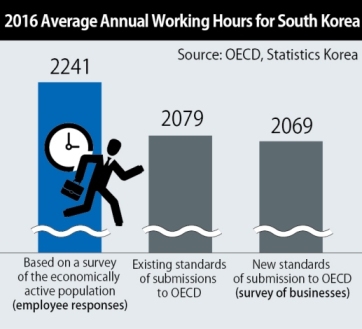 |
|
People rushing to work at the Gwanghwamun junction in Seoul. (by Shin So-young, staff photographer)
|
The country ranks second in average working hours among OECD nations, trailing only Mexico
Just how many work hours did South Koreans average last year – 2,241, or 2,069? The annual work hours of South Korean employees – the second most among OECD member states, after Mexico – have been undercounted, one scholar claims. This is likely to trigger a debate about the standards for compiling annual work hours, a figure often used in international comparisons. The claim appeared in a report titled “South Korea’s Work Hours Shrink at the Whim of Statistics Korea,” by Kim Yu-seon, a senior analyst at the Korea Labor and Society Institute. The report was published on Dec. 5. “Statistics Korea’s survey of the economically active population shows that the average annual work hours was 2,241, which was 172 hours fewer than the figure of 2,069 which was submitted to the OECD. The reason for this difference is that the work hours submitted to the OECD are supposed to be based on the economically active population survey, in which data is collected directly from employees, but were instead based on a survey administered to employers.” Kim argued in his report. There are two main methods used to calculate annual work hours. First, Statistics Korea uses the economically active population survey to ask employees aged 15 and above how many hours they worked in the week each month that contains the date of the 15th. Another method is the employer workforce survey conducted by the Ministry of Employment and Labor, which involves asking the owners of companies with five or more employees how many hours their employees work each month. These two surveys differ in who is responding (employees vs. employers), who is being surveyed (employees vs. wage earners), and what period is being surveyed (weekly vs. monthly), so the results vary as well. Statistics Korea uses the Ministry of Employment and Labor’s employer survey to determine the annual work hours of wage earners that it reports to the OECD and uses the economically active population survey to determine the work hours of the self-employed that it also reports to the OECD. The rationale is that the employer workforce survey, which compiles work hours on a monthly basis, is more stable than the economically active population survey, which compiles work hours on a weekly basis. But Kim is critical of this choice. “The economically active population survey is not only used for work hours – it reveals the employment rate and the unemployment rate, making it the most important indicator for job policy. Nor was it appropriate to start basing the OECD figures on the employer survey, considering that many have argued that this survey underestimates work hours,” he said. This was the year that Statistics Korea started using the employer survey as the basis for the figures submitted to the OECD. From 1980 until last year, first the Bank of Korea (before 2000) and then Statistics Korea (since 2000) used the economically active population survey as the basis for the employees’ annual work hours figure submitted to the OECD. But the original method of tabulating work hours conceals yet another problem: employees with less than a 30-hour workweek were given a weighted value of 0.5, while those with more than a 30-hour workweek were given a weighted value of 1. A spokesperson for Statistics Korea provided the following explanation for this practice: “The economically active population survey assesses the work hours per week. But since these weeks frequently exclude holidays such as Seollal [the Lunar New Year] and Chuseok [the Harvest Festival], simply multiplying this to calculate annual work hours can result in an overestimate. The self-employed also have a tendency of exaggerating their working hours in their responses. That’s why some figures were given weighted values back when the Bank of Korea was submitting the annual work hour figures.”
 |
|
2016 Average Annual Working Hours for South Korea
|







